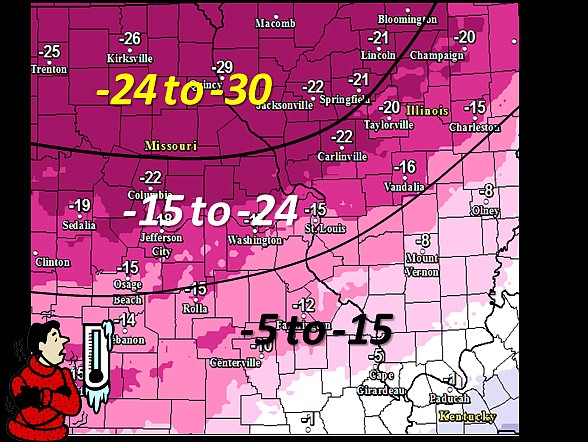Does this winter feel like it's been a little more brutal than usual?
Climatologists say it's not because this year has been a dramatic outlier, it's just that a series of milder winters has adjusted our expectations in recent years.
"We've become somewhat spoiled ... since 1990 we've had a lot of mild winters," said Pat Guinan climatologist for the University of Missouri Extension's Commercial Agriculture Program. "In fact, looking through history and the records go back to the 1800s - four of the top five warmest winters have been since 1990."
According to the National Weather Service, during this most recent storm, Jefferson City likely received between 4 to 6 inches of snow. Although his estimate isn't official, Jefferson City Operations Supervisor Britt Smith thought the city handled a six-inch deluge on Tuesday.
Over the past 11 months only September averaged warmer than normal, Guinan noted in his January 2014 report. Preliminary data for last month indicate the average statewide temperature was 25 degrees Fahrenheit, or 4.9 degrees below the long-term normal. 2010 and 2014 are the coldest Januaries since 1985.
On Jan. 5 an arctic cold front, accompanied by gusty winds, brought bitter wind chills and the coldest air mass in two decades across Missouri. Minimum temperatures dropped lower than -10 degrees Fahrenheit in many locations on Jan. 5-6. In addition, high temperatures on Jan. 6 remained at or below zero across parts of Missouri - an occurrence that hasn't happened since 1989.
"What we witnessed ... was a reality check," Guinan said.
Guinan said the historical record shows Missouri has experienced cold waves when the lowest temperatures plunged to 20 or 30 degrees below zero.
"For example, I remember the late 1970s. We had three consecutive winters that were brutally cold," Guinan said.
Tony Lupo, who chairs MU's Department of Atmospheric Science, said this year's temperatures are colder than normal, but he said the real story is the wild fluctuations in temperature we've experienced this winter.
"We're a bit lucky because this winter's temperatures have been on a roller coaster, otherwise we'd be talking about a situation like the late 1970s," he said.
It's been a while - about 18 to 25 years - since Missourians has experienced frigid temperatures of a magnitude and intensity comparable to 2013-14.
"I should also mention it's highly unusual for (daily) high temperatures to stay below zero, and that did happen," Guinan noted.
What will the rest of the season bring?
Climatologists believe El Niño and La Niña play a role in determining North American weather patterns. (El Niño is a band of warm ocean water temperatures that periodically develops off the western coast of South America and can cause climatic changes across the Pacific Ocean. La Niña is a counterpart to El Niño which occurs when the sea surface temperatures across the Atlantic ocean is colder than normal.)
"But right now we're in an El Niño Southern Oscillation neutral phase, which mean it's anyone's guess as to what might happen," Lupo said.
Although people don't notice dry weather in winter, Lupo said drought conditions from the summer of 2013 have continued this winter.
"This snow will reverse that, especially if it melts slowly," Lupo said.

